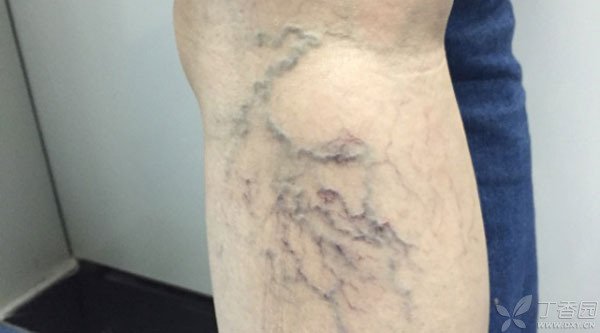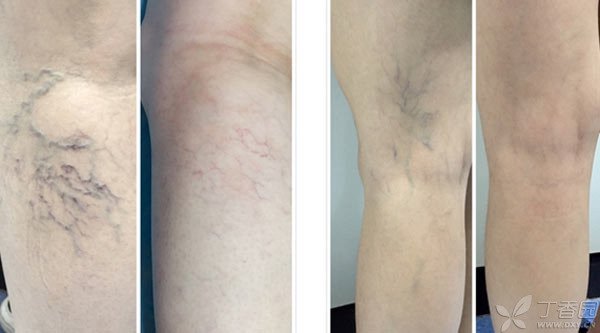
Women who love beauty can wear miniskirts all the year round, but many girls are ashamed to show their beautiful legs and wear long skirts and trousers all day long. Why?
The reason is the annoying [red blood streak]. Many women who love beauty are often troubled by this.
The scientific name of [red blood streak] is [telangiectasia], and many telangiectasia is accompanied by reticular varicose veins. Reticular varicose veins of the legs and telangiectasia are more common in women, usually have family inheritance, and are related to changes in hormone levels, most commonly occurring between the ages of 30 and 50.
According to reports, 50% of patients with leg reticular varicose veins and telangiectasia are accompanied by local pain and burning sensation, and some patients have symptoms such as leg swelling, nocturnal muscle spasm, leg soreness discomfort and pruritus.
What are the risk factors for [red blood streak]?
-
Gender: At any age, women are more likely to happen than men;
-
Genetic factors: Some people’s venous walls or valves are inherently weak;
-
Pregnancy and long-term use of contraceptives: During pregnancy, the circulating blood volume of women increases, thus increasing the pressure on the venous system. In addition, changes in hormones during pregnancy will lead to softening of venous walls and valves.
-
Obesity: Overweight increases venous pressure;
-
Occupational factors: For people who need to stand or sit for a long time to work, the possibility of suffering from this disease is high;
-
Trauma: Trauma, fall, bruise, cut or surgical incision may cause capillary dilatation in or near the affected area.
Look at the photo of the patient below. Besides [red blood streaks], she has thicker reticular varicose veins.

In the past, patients often did not care and delayed seeing a doctor, resulting in more and more serious symptoms. Moreover, there was no good treatment method before. Some patients with strong awareness of seeing a doctor went to the hospital to seek treatment, and the answer was often:
This does not need treatment, just wear elastic socks.
However, if it is not treated, the symptoms may become more and more serious, and some patients will suffer from itching, eczema and other symptoms.
More importantly, women are paying more and more attention to their image and quality of life, and the demand for treatment of capillary dilatation is also increasing day by day.
How should [red blood streak] be treated?
First of all, conservative treatment is ineffective. Elastic socks and drug therapy can only slow down the course of the disease. Varicose veins and capillary dilation that have occurred cannot disappear.
Secondly, the traditional open surgery is not suitable for such diseases either. Because the blood vessels of the lesions are too small, doctors cannot perform operations such as stripping.
Thirdly, intracavitary laser and radio frequency therapy cannot be implemented because some venous lumens are too small and shallow.
So, is there no treatment? No. At present, there are three main treatments for telangiectasia and reticular varicose veins.
1. Sclerotic injection therapy
Doctors who treat telangiectasia include vascular surgeons, dermatologists and plastic and cosmetic surgeons. Liquid sclerosing agents or foam sclerosing agents are used for treatment according to different vascular diameters.
2. Laser therapy
In recent years, laser has been widely used in the treatment of vascular diseases. According to the different skin color, skin quality and vascular diameter of patients, the reticular vein dilation will gradually narrow and close when appropriate laser energy and pulse width are selected.
3. Combination therapy
Due to the limitation of tube diameter, sclerosing agent can be successfully injected only for capillary dilation with thicker diameter (generally larger than 1 mm), while it is difficult for capillary dilation with thinner tube diameter.
Of course, some of the thinner capillaries can be gradually occluded after the thicker blood vessels are injected, but most patients still have residual blood vessels that cannot disappear. At this time, sclerosing agent injection combined with laser therapy is needed.
The two treatment methods act respectively according to different stages of the treatment process and different diameters of blood vessels, making up for each other and bringing out the best in each other.
[Red Blood Streak] Is there any side effect of what after treatment?
It should be noted that there will be local induration in a short period of time after injection of sclerosing agent, and pigmentation in varicose veins of some patients will gradually fade away after treatment. Patients need to wear elastic socks for 2 weeks to 1 month after treatment. In addition, a few patients will have recurrence. Wearing elastic socks can reduce the probability of recurrence after operation.
Look at the following photos of these patients after treatment. Are they much more beautiful? The common feeling of many patients after treatment is [I can finally wear a short skirt! ]

With the improvement of economic level and people’s quality of life, people’s requirements for beauty are getting higher and higher, and they put forward delicate and sexy requirements, requiring skin texture/color to be delicate and flawless.
Skin is the largest organ of the human body, protecting all organs, is the natural coat of human beings, and is also an important symbol of human beauty. Healthy skin embodies a good mental outlook and confident attitude. Blood vessels, as a component of skin, not only transport blood, supply nutrition to skin, greatly affect the beauty of skin.
Therefore, ladies who love beauty, get rid of the annoying [red blood streak] and bravely show off their beautiful legs!
Responsible Editor: Huang Lijia
